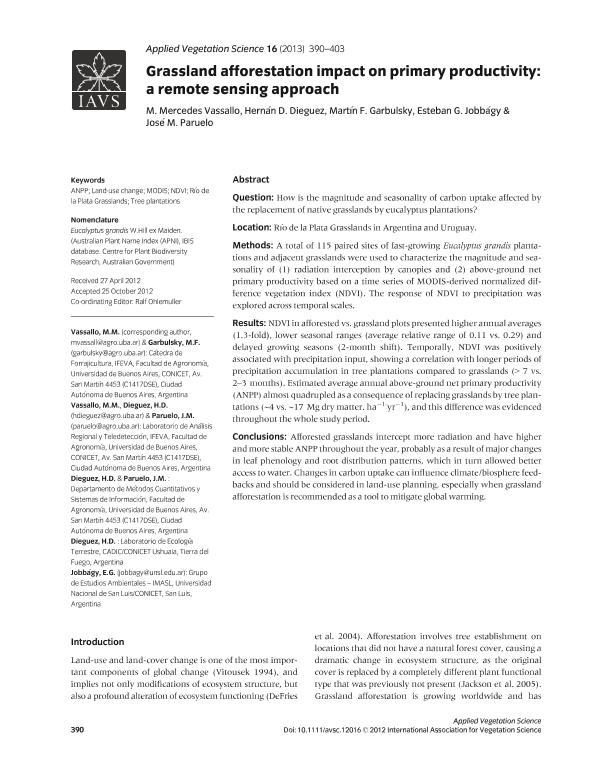Artículo
Grassland afforestation impact on primary productivity: A remote sensing approach
Vassallo, Maria Mercedes ; Dieguez, Hernan Dario
; Dieguez, Hernan Dario ; Garbulsky, Martín Fabio
; Garbulsky, Martín Fabio ; Jobbagy Gampel, Esteban Gabriel
; Jobbagy Gampel, Esteban Gabriel ; Paruelo, José
; Paruelo, José
 ; Dieguez, Hernan Dario
; Dieguez, Hernan Dario ; Garbulsky, Martín Fabio
; Garbulsky, Martín Fabio ; Jobbagy Gampel, Esteban Gabriel
; Jobbagy Gampel, Esteban Gabriel ; Paruelo, José
; Paruelo, José
Fecha de publicación:
07/2013
Editorial:
Wiley Blackwell Publishing, Inc
Revista:
Applied Vegetation Science
ISSN:
1402-2001
Idioma:
Inglés
Tipo de recurso:
Artículo publicado
Clasificación temática:
Resumen
Question: How is the magnitude and seasonality of carbon uptake affected by the replacement of native grasslands by eucalyptus plantations? Location: Río de la Plata Grasslands in Argentina and Uruguay. Methods: A total of 115 paired sites of fast-growing Eucalyptus grandis plantations and adjacent grasslands were used to characterize the magnitude and seasonality of (1) radiation interception by canopies and (2) above-ground net primary productivity based on a time series of MODIS-derived normalized difference vegetation index (NDVI). The response of NDVI to precipitation was explored across temporal scales. Results: NDVI in afforested vs. grassland plots presented higher annual averages (1.3-fold), lower seasonal ranges (average relative range of 0.11 vs. 0.29) and delayed growing seasons (2-month shift). Temporally, NDVI was positively associated with precipitation input, showing a correlation with longer periods of precipitation accumulation in tree plantations compared to grasslands (> 7 vs. 2-3 months). Estimated average annual above-ground net primary productivity (ANPP) almost quadrupled as a consequence of replacing grasslands by tree plantations (∼4 vs. ∼17 Mg dry matter. ha-1·yr-1), and this difference was evidenced throughout the whole study period. Conclusions: Afforested grasslands intercept more radiation and have higher and more stable ANPP throughout the year, probably as a result of major changes in leaf phenology and root distribution patterns, which in turn allowed better access to water. Changes in carbon uptake can influence climate/biosphere feedbacks and should be considered in land-use planning, especially when grassland afforestation is recommended as a tool to mitigate global warming.
Archivos asociados
Licencia
Identificadores
Colecciones
Articulos(IFEVA)
Articulos de INST.D/INV.FISIOLOGICAS Y ECO.VINCULADAS A L/AGRIC
Articulos de INST.D/INV.FISIOLOGICAS Y ECO.VINCULADAS A L/AGRIC
Articulos(IMASL)
Articulos de INST. DE MATEMATICA APLICADA DE SAN LUIS
Articulos de INST. DE MATEMATICA APLICADA DE SAN LUIS
Citación
Vassallo, Maria Mercedes; Dieguez, Hernan Dario; Garbulsky, Martín Fabio; Jobbagy Gampel, Esteban Gabriel; Paruelo, José; Grassland afforestation impact on primary productivity: A remote sensing approach; Wiley Blackwell Publishing, Inc; Applied Vegetation Science; 16; 3; 7-2013; 390-403
Compartir
Altmétricas



